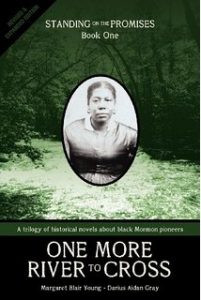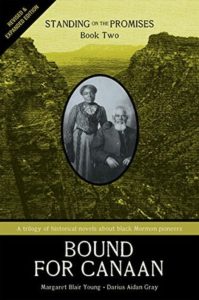 Title: Standing on the Promises
Title: Standing on the Promises
Book I-One More River To Cross
Book 2-Bound for Canaan
Authors: Margaret Blair Young and Darius Aidan Gray
Deseret Book 2000, 2002 (republished by Zarahemla Books, 2012, 2013)
Reviewed by Erin Cowles, November 2019
One More River to Cross (Volume 1)
This book had been on my to read list the second longest (since 2008), and it was a completely different reading experience because I waited so long to pick it up. Both would have been good, but I know an awful lot more LDS history now than I did then. A 2008 reading experience would have opened my eyes to completely new information; a 2019 reading made me appreciate how well-crafted and researched this book was.
I have heard this described as “The Work and the Glory for black pioneers,” but I never actually read The Work and the Glory, so I don’t know how it compares. What this did remind me of was the style of the church’s current Saints series. Both aim to provide well-documented historical information through the medium of narrative fiction, leaning more heavily on the history side than the fiction side. I noticed some reviewers complained about this, but I think this form was absolutely essential considering when this came out. In 2000, I had no idea there were black Mormons ordained to the priesthood in Joseph Smith’s time, and I doubt I was in the minority on that count. The priesthood ban is such an emotionally charged topic, and we did not have anywhere near the level of transparency about our history that we currently enjoy (or the same ability as a people to handle the nuances of things like beloved figures making terrible decisions or contradicting each other), so I think sticking to documented facts as often as possible and including copious endnotes at the end of every chapter was essential, and led people to a lot of great sources to learn more.
The greatest value for me reading this, as someone that went in with a fairly solid arc of the two main characters’ lives, was contextualizing their lives within black history, rather than Mormon history. There are so many things I am ashamed to say I never considered – what the doctrine of eternal families would mean to slaves who couldn’t even hope to keep their children from being sold away, what it would mean to be ordained a 70 and a missionary when you grew up in a system that told you God had cursed you or didn’t even give you a proper soul, and how polygamy would look to you when the concept of white men raping black women and having children by them was so commonplace. I went into this book with a good grasp of the facts of their lives; I left with a far better understanding of how it felt to live those lives.
The research was excellent and well-utilized, it asked difficult questions while staying absolutely faithful, and it showed just how amazing these individuals were while keeping them very human. I am excited to pick up the next volume (which will include a lot of new information for me, because I am less familiar with the black Mormons that came to Utah as slaves).
Gray and Young strike the right balance between acknowledging the pain and wrong done to these saints, while still staying absolutely faithful. I really love how their protagonists are inspiring, but still feel very human. And I thought their treatment of the white saints was brilliant – holding people absolutely accountable (especially the straight up hateful ones), while giving the characters with more benign racism enough nuance, complexity, and empathy that they can function as a lens for our society and ourselves, and the ways our biases do harm and have consequences.

